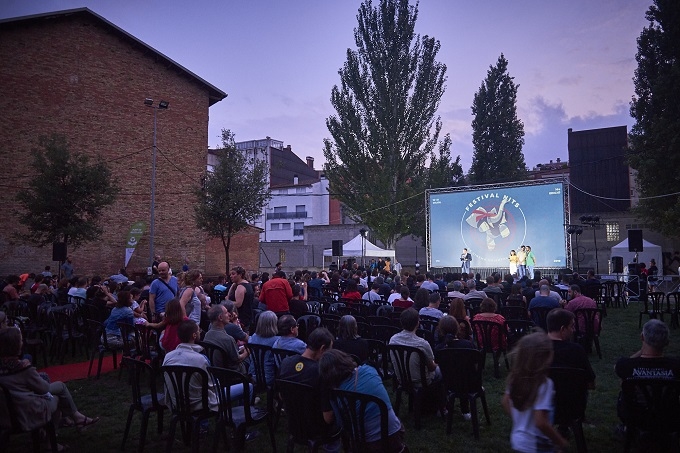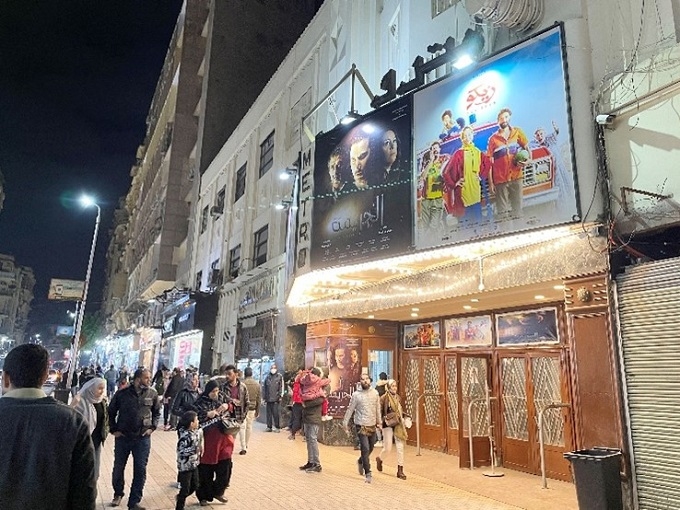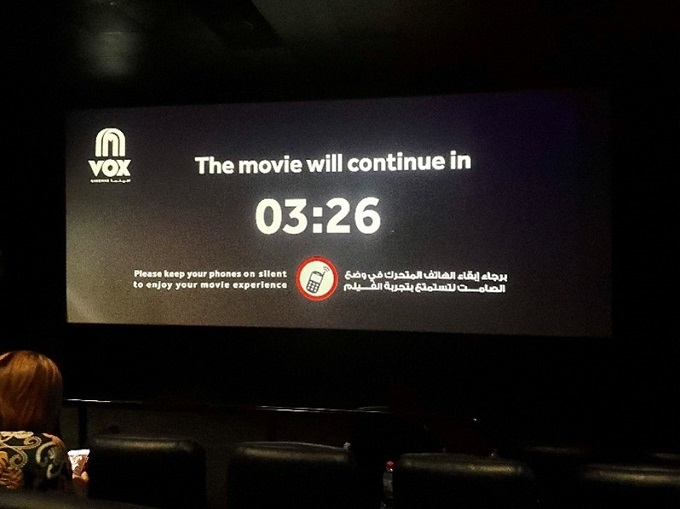Movie Theaters around the World <3>
Okazaki Yuko, freelance writer and editor, contributor
Ways to Enjoy Movies (Part 2)
February 19, 2024
【Special Feature 079】
Special Feature: Movie Theaters around the World (click here for summary)
In Japan, the proper etiquette at movie theaters is to quietly watch the movie until the end. However, in theaters in other countries, that may not be the norm. Movies are a form of entertainment enjoyed around the world, but what kind of theaters do people go to and how do they enjoy watching? Here, we will take a look at some examples of film culture around the world.
See Ways to Enjoy Movies (Part 1) here
Ways to Enjoy Movies (Part 2)
Okazaki Yuko
7. United States
In Japan, we hear in some form or another about the situation regarding American movies, which boast the largest number of screens, attendance, and box-office records in the world by far. Time and again, we have seen news of multiplexes operated by the world's leading movie theater companies, AMC Entertainment and Regal Cinemas, struggling amid the COVID-19 pandemic. Rather than resigning themselves to the situation, the two companies' theaters are still taking a variety of steps to turn things around.
For example, AMC has launched a rental program plan for private screenings that has generated a great deal of interest and allows customers to screen a movie of their choosing in a private theater that they can rent for 99. Conversely, in February 2023, the company introduced a system of variable pricing based on seat location, to the bemusement of many movie-goers.
In addition to AMC and Regal, there are several other movie theater chains in North America, including Cinemark and United, many of which feature large screens, such as IMAX. Some of them can project on large screens for films shot in 65mm and 70mm. In Japan, the National Film Archive is the only facility that screens 70mm films, so this is something I really envy.
Another strength of multiplexes is their facilities for showing special formats like 3D, 4DX, and ScreenX, and in addition to their impressive technical specs, they offer much in the way of titles as well. These multiplexes offer a wide range of special events, such as screening classic films to celebrate their anniversaries, and showing foreign films tailored to the needs of local minority communities.
On the other hand, there are also smaller movie theaters, such as second-run theaters, known as "discount theaters", and independent theaters. Discount movie theaters have a relatively small number of screens showing second-run films (older films as well as new releases that have not yet been shown at multiplexes), but it is sad that the number of those theaters is dwindling these days.
Meanwhile, many independent movie theaters have only one screen and offer distinctive programs, such as classic films, revival screenings of famous films, Q&A sessions with cast and crew for movie fans, themed nights, and movie marathons.
Late-night screenings are also a regular occurrence, and at screenings of
Clue, The Room, and The Rocky Horror Picture Show, which have already been old staples for years, fans who have seen the films numerous times come dressed as the characters, set off party poppers, and yell out the famous lines. It's wonderful that these are not one-off events and that they have new fans taking part every year.
A typical example of an unusual movie theater is historic theaters maintained by preservation groups. Although they do not screen new releases, they do show classic films, sometimes with live orchestral music.
There are also a variety of places to see films other than theaters. Drive-in theaters have long been popular, and even now after the pandemic has abated, they are still held in many places. As the name implies, you park your car in the lot and watch the movie from inside, while waiters on roller blades come to your car and take your orders for snacks and drinks. Nowadays, you can open the window to listen to the sound of the movie, but when the first drive-in theaters appeared, audiences would often listen over their car radios.
In addition, outdoor screenings are held in various locations such as Central Park in New York City and Hollywood Forever (a cemetery!) in Los Angeles, and people can often be seen putting up their own tents on the beach to watch movies at night.
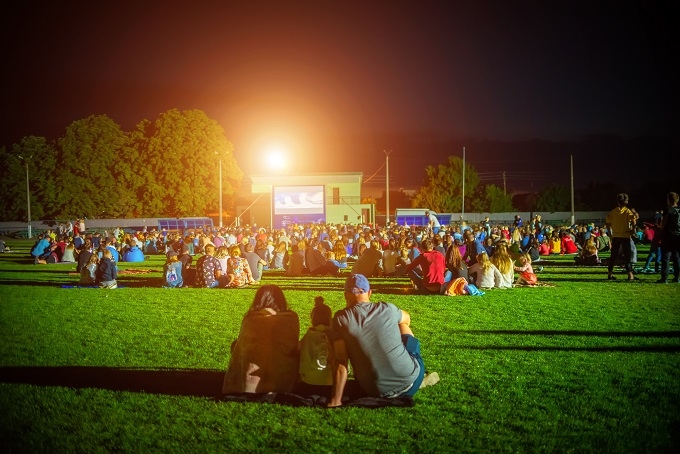 Outdoor screenings can be enjoyed like a picnic, sitting on the grass (The Northfield Drive-in Theatre, New Hampshire).
Outdoor screenings can be enjoyed like a picnic, sitting on the grass (The Northfield Drive-in Theatre, New Hampshire).8. Canada
In Canada, there are multiplexes and mini-theaters where people can enjoy a variety of productions, including not only blockbusters but also documentaries, indie films, art films, and more.
Once, a screening was interrupted due to technical problems, but there were no boos or complaints. When the movie resumed, applause erupted from the audience, making the whole experience pleasant. Laughter, sighs, and applause are often heard while a movie is playing, indicating that the moviegoing atmosphere is extremely enjoyable and welcoming.
Led by the world-famous Toronto International Film Festival, a diverse variety of movie festivals, which only a multicultural nation can offer, are held throughout the country. One such gathering is the Toronto Japanese Film Festival, screening more than 20 of the latest Japanese films and attended by directors and actors from Japan. A re-importation of this festival to Japan, called the "Toronto Japanese Film Festival in Hibiya," has been held four times. As it screens movies with English subtitles, a rarity in Japan, this festival is also appreciated by foreign residents.
In addition, on "National Canadian Film Day," movies are shown free of charge at more than 1,000 theaters, libraries, and other locations across the country, and the event continues to gain popularity year after year.
9. Mexico
In recent years, a number of Mexican directors have been nominated for Academy Awards, including Alfonso Cuarón, Alejandro González Iñárritu , and Guillermo del Toro. It is no exaggeration to say that the Mexican film industry has taken Hollywood by storm, including Emmanuel Lubezki, the first cinematographer in history to win the Oscar three years in a row for Gravity, Birdman or (The Unexpected Virtue of Ignorance), and The Revenant.
In Mexico, a country that has thrown up such talented persons, everyone has been watching movies often since childhood. On weekends, movie theaters are visited by many families, and they really laugh a lot. This happens even during Japanese films, and even when the scene is not made intentionally funny by the director (!).
Reactions range from giggles to guffaws. When I hear this laughter, I think with deep emotion about how everyone is sharing the same space and time to watch the film. Not watching the credits to the end is common in all countries. So, in Mexico, it seems that those manners are common, too.
Incidentally, the admission fee to a movie theater in Mexico is about 600 yen. Some VIP rooms have reclining seats, where you can order from the restaurant and bar menu from your seat, and even a waiting room with a bar counter (drinks are extra). Being able to enjoy these luxurious seats for only about 1,400 yen must be an irresistible experience for moviegoers.
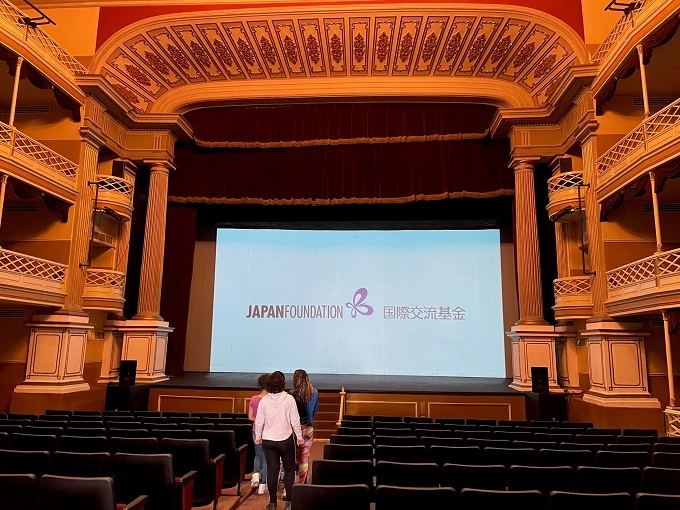 Preparations for the Japanese Film Festival at the Teatro Aguascalientes. In Mexico, movies are also sometimes shown at venues for theatrical works.
Preparations for the Japanese Film Festival at the Teatro Aguascalientes. In Mexico, movies are also sometimes shown at venues for theatrical works.
Another hallmark of movie theaters in Mexico is that nachos are on the menu alongside popcorn at the concession stand. Nachos are tortilla chips (corn dough, rolled out thinly and cut into shapes, then fried or baked) topped with melted cheddar cheese and served to taste with a salsa made from jalapeños, a type of hot pepper. Extra cheese can be added, and nachos are one of the most popular items on the menu, an essential accompaniment to movies.
10. Russia
Ever since the deterioration of the situation in Ukraine, Russian theaters have been unable to screen films from abroad. Moreover, with many theaters driven out of business during the COVID-19 pandemic, the film industry is facing a difficult situation. However, new French and Italian films continue to be shown, and there were also some Western films shown in the Moscow International Film Festival.
Since the Soviet era, cinema has been one of the main forms of entertainment for the Russian people, and has been highly regarded as an art form. In search of "something new they have never encountered before," they have an endless interest in famous directors, well-known films, and films that have been acclaimed in Europe and elsewhere, regardless of the year in which they were made.
Whether films are new or old, audiences tend to flock to prominent films and prominent directors, and when they held special features on Ozu Yasujiro and Kurosawa Akira, films that had been shown many times in the past, such as Tokyo Story and Seven Samurai, attracted bigger audiences than films shown in Russia for the first time, with less opportunities to see.
Movie theaters in Moscow and other large cities play an important role as entertainment facilities, and on weeknights and holidays they are very crowded with families, couples, and groups of friends. There are various types of movie theaters, including those that show the usual new releases, those that offer subtitled films to the public (since dubbing is common in Russia, they are very popular with audiences who want to enjoy the original audio), those that specialize in independent films, and those that specialize in classic Russian films.
Film festivals that screen foreign films are also very popular and, as the name suggests, are really seen as a kind of festival. Many people come in cosplay when the Japanese Film Festival is held, and there are even hardcore fans who are not satisfied unless they watch all the films in the program. One year, when the festival held a contest for the number of films seen, with the winner receiving festival merchandise, there were more attendees than expected who saw all the films, and they had trouble dividing up the prizes.
We can only hope that the situation in Ukraine will stabilize and we can return to a time when, as before, Russian films can be enjoyed around the world, foreign films can be enjoyed in Russia, and we can have a relationship with Russian filmmakers.
11. United Kingdom
Along with the United States, the United Kingdom, with its thriving film industry, has produced some of the greatest directors in the history of film, including Alfred Hitchcock, Ridley Scott, and Christopher Nolan. Movies also contribute to bringing in tourists. Tours of famous movie sets, such as Pinewood Studios, where the James Bond series were shot, as well as tours of on-site filming locations for series like Harry Potter and Game of Thrones, are gaining popularity.
In the UK, strict building regulations make it difficult to put up new buildings. As a result, theater tours have become a fun activity for film fans, with halls and playhouses being converted into movie theaters and old-fashioned theaters being preserved as they were in the past. Online, you can find information not only on what films to see, but also which theaters to visit.
In recent years, upscale movie theaters are emerging, with sofa seats for couples and ample leg room on squashy cushions. Not only that, but movie theaters are trying various ideas, including video screenings of works performed at the National Theatre or opera houses, "secret cinemas" in which the title of the film is not revealed, and film programs that include special activities, like "sing-alongs," in which the audience can sing the songs in the film together.
12. Germany
In Germany, a world leader in terms of environmental awareness, ecology is also an important theme in movie theaters. Since 2018, the FFA (German Federal Film Board) has been providing information entitled Grünes Kino ("Green Cinema"), which includes distributing handbooks for the environmentally sustainable operation of movie theaters.
Also, in Germany, with its long and cold winters, summer is an important vacation season! Sunset is at 10:00 p.m., and to provide entertainment for the long evenings, various outdoor cinema events take place in venues such as historic buildings, waterfront, and drive-in theaters.
In Cologne, outdoor film screenings held on boats on the Rhine River, sponsored by the local beer company, have been a roaring success. This is surely the kind of thing you can enjoy in Germany, a country where people enjoy a beer festival.
13. Italy
Movies are also a popular form of entertainment in Italy. After dinner, couples and groups of friends often go to the movies together. Screenings usually start at around 9:00 p.m. The number of attendees seems to be the highest on Saturdays. However, people often do not arrive on time for the start of the show. Many of them come late (there might be a problem with public transport, traffic congestion, or parking).
The price of admission varies depending on the time of the screening, averaging 9 euros for the most crowded weekend and nighttime slots. Another enviable difference is that weekday daytime screenings cost around 7 euros, less expensive than in Japan.
Movie theaters in city centers are almost exclusively mini-theaters. Multiplexes, such as those located in shopping malls, are usually found in the suburbs. Recently, Hollywood movies such as the Marvel series have become popular among young people, but as a rule, foreign movies are screened dubbed. Italy has a specialized school for training dubbing voice actors, and its high standards are widely known around the world. Although screenings with the original audio and subtitles are only available in a few cinemas, today's young people seem to prefer watching in the original language.
14. Spain
Spain hosts more than 70 film festivals a year in different locations, including major festivals such as the San Sebastian International Film Festival or the Sitges Film Festival, which are renowned throughout Europe, as well as festivals aimed at more niche audience, such as the NITS Oriental Film Festival. During those periods, people are happy to see films that interest them, and this has made film a familiar form of entertainment for the public.
Movie theaters also vary depending on the style of viewing, such as old established theaters with long histories, theaters where you can watch movies in a café atmosphere, outdoor screenings, and so on.
The way the Spanish audiences enjoy movies is as diverse as the type of festivals and sometimes, very different from that in Japan, with cheering and applause at some screenings. Everyone seems to have their own way of enjoying films, and there are many instances at fantasy and horror film festivals where people laugh at scenes that are supposed to be scary in horror films, or where they jeer and laugh during grisly murders in suspense films. Seeing people like this is one of the pleasures of going to watch movies.
Among Japanese films, anime works are popular, and when One Piece Film: Red was screened, the mere appearance of Luffy, the main character made the venue full of applause and screams of delight, matching a popstar's level of popularity.
15. Hungary
In Hungary, the sun sets much later in the summer, so open-air screenings are held all over the country. For example, at the summer film festival on Margaret Island, about 500 people gather together, and each one brings a ground sheet, to the athletic field in the park and start watching a movie at around 9:00 p.m.
There are also outdoor screenings held on the rooftops of buildings in the middle of the city, allowing audiences to enjoy movies in an atmosphere different from that of a movie theater. Enjoying a film during evenings that grow dark very slowly is a unique part of Hungarian culture.
On the other hand, there are also luxurious movie theaters like "Uránia Nemzeti Filmszínház" and "Puskin Mozi," which look like opera houses. You can also enjoy movies in an atmosphere quite unlike that of outdoor screenings or cinema complexes located in shopping malls.
16. Egypt
Egypt, in North Africa, has almost no mini-theaters, so people go to cinema complexes attached to shopping malls or to theaters located in town centers.
In particular, new movies are released to coincide with Eid or the vacations after Ramadan, so young people rush to movie theaters during the holiday season.
However, screenings do not always start on time, so if a screening is scheduled for 7:00 p.m., it may not actually start until around 8:00 p.m. Everyone is aware of this and arrives at the theater about 7:30 p.m., so there are no particular complaints.
Moreover, there is sometimes a 5-10 minute intermission in the middle of the film, and at that time, the image stops abruptly. The audience also regard this as a routine occurrence and spend the break as they like, going to the restroom, making phone calls, buying food, and so on.
In addition, even during the movie, cell phones frequently ring and people pick up to talk to whoever called them. Despite that, nobody boos, and the calm atmosphere throughout makes for a pleasant experience.
When the main feature ends, the lights come on and almost everyone in the audience stands up and prepares to leave without watching the end credits. It seems to be taken for granted that the screening ends with the main feature.
17. Kenya
Movies are also a popular form of entertainment in Kenya, located about 3,000 km south of Egypt. In the capital city of Nairobi, cinema complexes with the latest equipment can be found in large shopping malls, but in the traditional shopping and entertainment districts, there are also several mini-theaters that cater to the tastes of particular audiences, such as those that specialize in Indian movies and those offering an action-oriented new and old lineup of very popular kung-fu movies.
Furthermore, about 1,000 km east of Nairobi, almost at the border with Somalia, there is a small island called Lamu. Most of the residents are Muslims, and during Mawlid, a festival celebrating the birth of the Prophet Mohammed, the founder of Islam, the island becomes a little Mecca, and many Muslims from African countries visit the island.
Today, tuk-tuks drive through the streets, but until a little more than a decade ago, there was only a single military vehicle on the island, and people got around exclusively on foot or by donkey. In this rural part of the country, where the town landscape and people's lives may have remained unchanged for a hundred years, there were also two movie theaters.
One of them is an open-air cinema that screens films every weekend on the grounds where the mosque is located. Watching a movie under the stars on a white cloth attached to palm trees, listening to the sound of the waves, was a nostalgic experience. The program includes Indian films and old Hollywood movies, with different genres and themes every week. There is no particular announcement as to what will be shown, but people find out what is showing that day through word of mouth typical of the locals, and depending on what it is, the audience might be families, couples, groups of men hanging out together, or elderly people brought along by their children. I was really surprised by that kind of information network.
The next day, everyone livens up about the story of the movie, and it was heartwarming to see the talkative ones who had seen the movie telling the story to those who couldn't go.
Related Articles
Back Issues
- 2025.6.24 Exclusive Interview:…
- 2025.5. 1 Ukrainian-Japanese I…
- 2024.11. 1 Placed together, we …
- 2024.5.24 The 50th Japan Found…
- 2024.5.24 The 50th Japan Found…
- 2024.5. 2 People-to-People Exc…
- 2024.2.19 Movie Theaters aroun…
- 2024.2.19 Movie Theaters aroun…
- 2023.4.24 The 49th Japan Found…
- 2022.10.24 Inner Diversity <2> …


